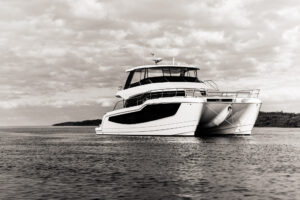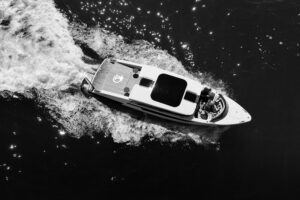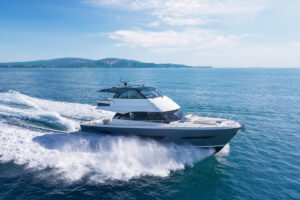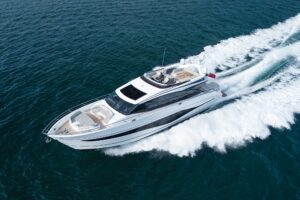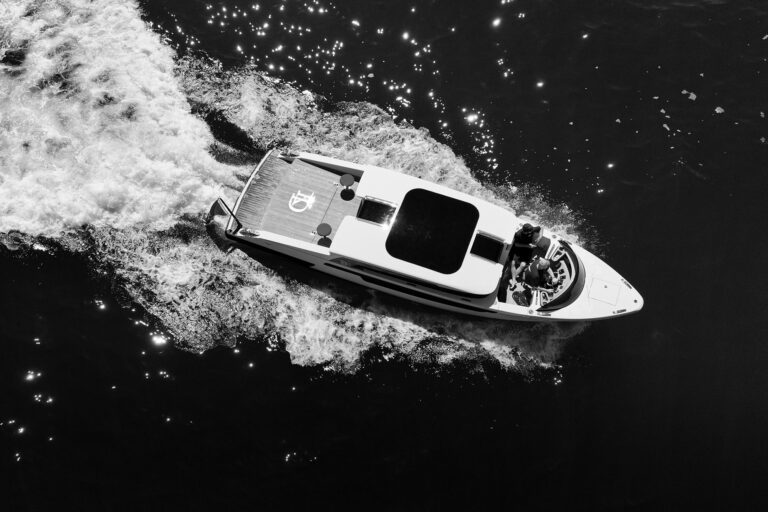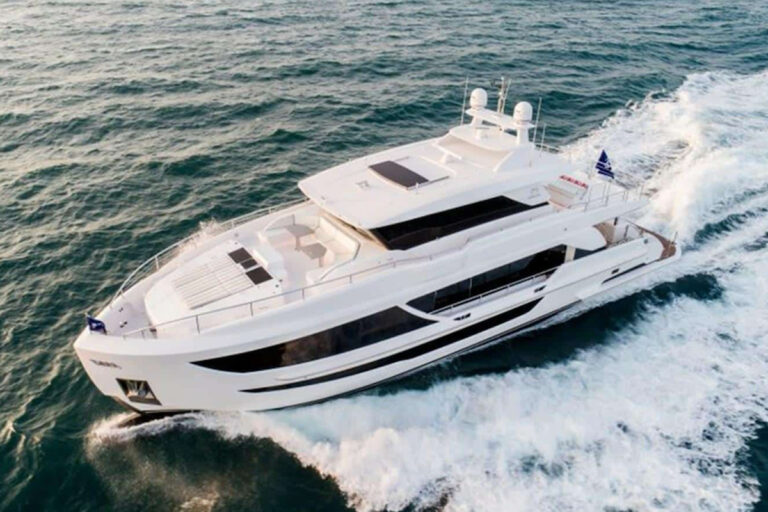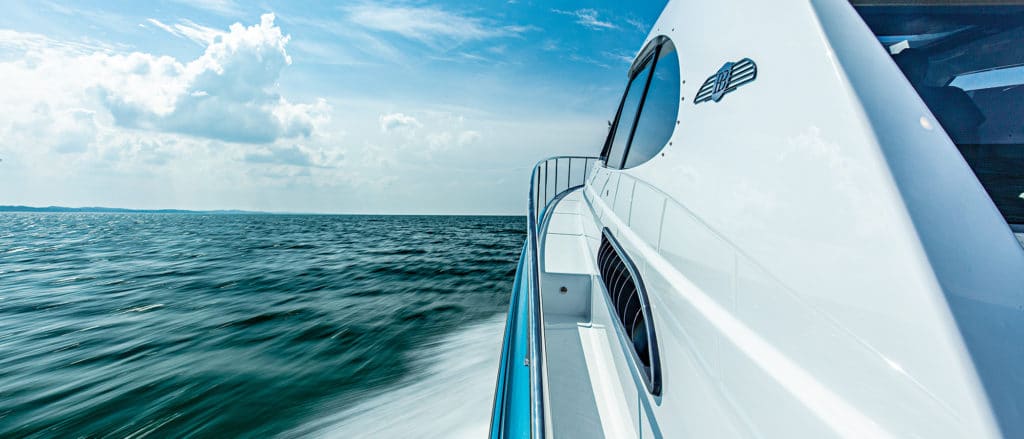
The sea of fiberglass seemed endless.
Chesapeake Harbour Marina in Annapolis, Maryland, has 200 slips on 10 docks, and I feared there was no chance of ever finding the Palm Beach GT50.
I needn’t have worried. It took about 10 seconds for my eyes to land on the metallic-blue hull, with its tumblehome and radiused transition to the topsides, capped by a curvaceous white cabin with a wraparound windshield and a raked mast. The Palm Beach GT50 dominated the aquatic landscape and somehow made 199 other boats seem to disappear. Poof!
Palm Beach aspired to create what it calls “visual elegance” in this yacht, the first of a series that is intended to include 60- and 70-foot models. In that regard, and many others, the builder succeeded.
But good looks only get you so far. High speeds and notable fuel efficiency also were goals for the GT50. To get there, Palm Beach fully infused the hull with vinylester resin and E-glass, and cored it with Corecell. The deck and superstructure were also fully infused, and laid up with carbon fiber. Net result? A 28,660-pound displacement at half load. That’s about the same weight as many traditionally built fiberglass boats with 5 or even 10 fewer feet length overall.
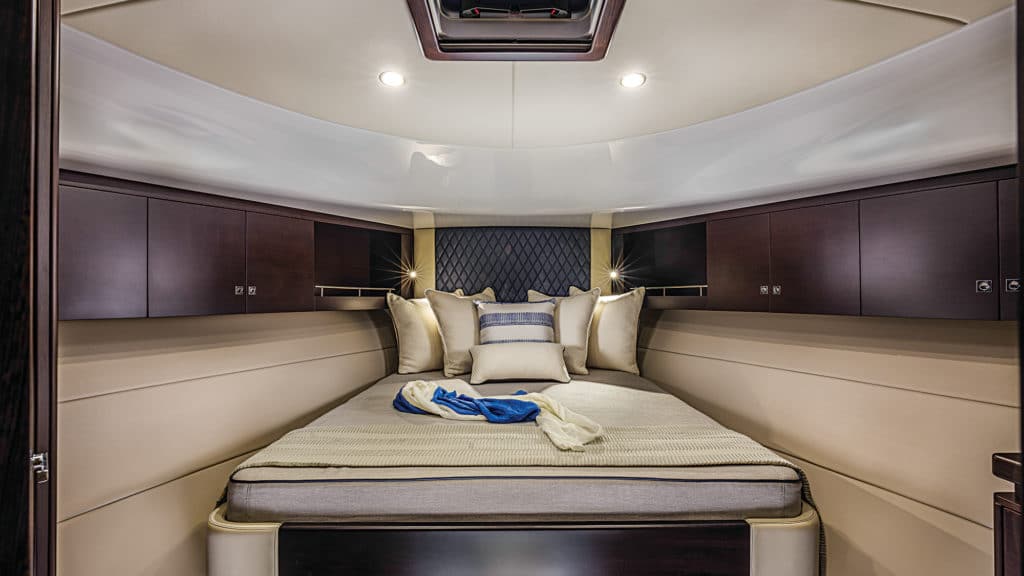
Combine the yacht’s light weight with a fine entry and a warped-V hull form, and you get a top-end that should break 40 knots. My test boat that day in Annapolis was the prototype yet, even prior to tweaking the propsets, it hit 35.9 knots. The builder later swapped out props and now reports 42 knots at wide-open throttle.
The prototype’s seakeeping ability also was noteworthy. Sure, I expected a 50-footer to flatten out the wakes, but thanks to that entry and the low center of gravity resulting from a single, centered fuel tank, I would have felt comfortable resting a glass of red wine on the galley countertop while running full tilt into a 2-foot chop.
And speaking of wineglasses, the interior of the GT50 lives up to the promise of the yacht’s exterior beauty, but in a different way. While the boat’s lines have a sleek, classic appeal, the interior is modern chic. Dark wenge-wood accents and cabinetry are set off against light countertops, the white headliner and a faux-teak deck, while the 360-degree windows and sunroof measuring 59 inches wide by 40 inches long bring in natural light. Similarly, the two-tone, cream-and-silver diamond stitching in the salon upholstery creates a visual juxtaposition that’s appealing.
Palm Beach maximizes salon space with a galley-down design. There’s a head with a shower that’s twice the size I’d expect to see on a boat of this nature. The two staterooms are similarly spacious. While many builders would try to add a third stateroom, Palm Beach instead kept the interior areas relatively open. It’s a smart move on a yacht that’s most likely to be used for day cruising and weekending with a couple or two aboard. (That’s not to say that you couldn’t spend a week or more aboard — you certainly could.)
An all-important social space on a yacht like this is, of course, the cockpit. In this case, it’s capped with a pair of L-shaped lounges aft, with a center walk-through to the swim platform. Forward to port, there’s a wet bar with an ice maker and stowage, including dedicated stowage for the glassware that comes with the GT50. In its endeavor to deliver a turnkey boat, Palm Beach made those wineglasses standard.
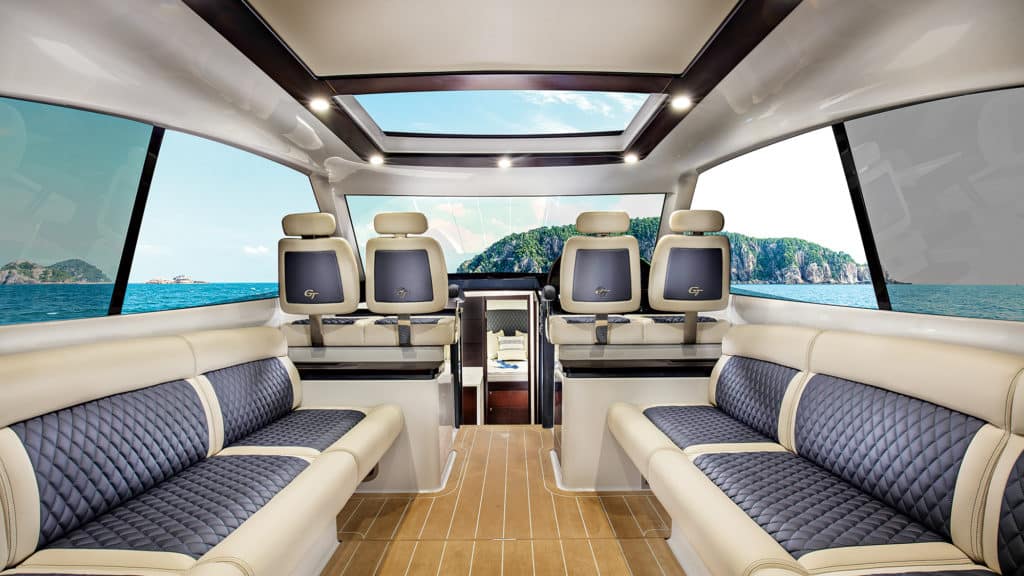
Walking from the cockpit to the bow, the side decks vary from 11.2 inches wide at their narrowest to 12.6 inches at their widest, and are capped with a raised toe kick and ringed by a stout rail that’s 1.25 inches in diameter. The engine-room vent louvers on the prototype project out into the side deck, enough to bump an ankle, but Palm Beach planned an adjustment for future hulls.
The anchor locker on the GT50 hides a bow pulpit that swings up and out, allowing for easy anchoring without piercing the bow with one of those through-hull rigs that are so popular these days — and that interrupt a sleek bow’s lines. There’s also enough room inside the locker to stow several large fenders.
Fast-forward to two days after my sea trial, to the opening of the United States Powerboat Show in Annapolis. I was walking across the Eastport Bridge with a bird’s-eye view of the show. As I gazed across the docks, those metallic-blue curves once again grabbed my attention. They drew my eye from a sea of fiberglass. All those other boats seemed to disappear. Again.
The Palm Beach GT50, clearly, can work magic.
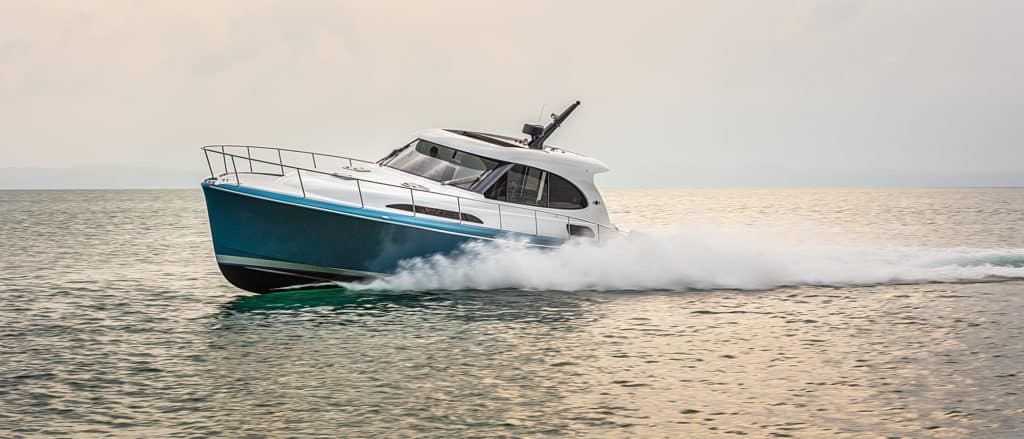
Material Choices
Why use simulated teak instead of the real thing? Palm Beach wanted to offer hose-and-go maintenance. Yachtsmen said they didn’t want to have to worry about sandy feet and sunblock when walking into the cabin, and today’s synthetic materials are far easier than wood to clean and maintain.
Weighty Decisions
For optimizing weight distribution and the boat’s center of gravity, Palm Beach uses a single, centered fuel tank. Volvo Penta’s 600 hp IPS800 diesels are shifted forward. To maintain the ideal position of the drive units, the diesels are then jack-shafted to the pod drives.
Breath of Fresh Air
While cruising across Chesapeake Bay aboard the Palm Beach GT50, I felt almost like I was in an open model as opposed to an express, thanks to opening side and aft windows, and a sunroof. Naturally, all of them open at the press of a button, and for those who want even more fresh air, Palm Beach offers the GT50 in an open version.

